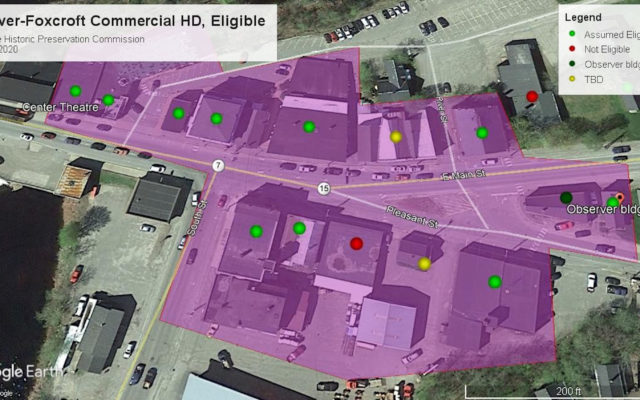
Historic downtown Dover-Foxcroft earns a spot on National Register
By Valerie Royzman, Staff Writer
Nineteen buildings along East Main Street earned recognition as the Dover-Foxcroft Commercial Historic District, which is now on the National Register of Historic Places.
The designation for Dover-Foxcroft’s downtown comes with advantages for the properties within the district, such as access to grant opportunities, federal income tax incentives for renovation projects and recognition for the community, which has the potential to draw more people and businesses to the area.
Fifty-six other buildings and archeological sites throughout Piscataquis County are listed individually on the National Register of Historic Places, but this is the first commercial downtown historic district receiving such a designation in the county, Michael Goebel-Bain, the national register and survey coordinator for the Maine Historic Preservation Commission, said.
“The hope is that having the district in place will mean that several historic buildings might now look more attractive to investors who will want to purchase them,” Patrick Myers, executive director of the Center Theatre for the Performing Arts, said. “For current owners, they might want to renovate them and make them useful, vibrant parts of the community again.”
Myers took the lead on the project about a year ago when he began exploring funding opportunities for the theater. That led him to working closely with the Maine Historic Preservation Commission and a consultant to prepare the necessary research and documentation that would eventually earn the district a spot on the National Register.
Once Myers gained the town’s approval and notified local property owners and organizations, he coordinated public meetings and gave people a chance to ask questions and learn about the process.
“There were certainly some folks who were concerned that if there was a commercial historic district in town, that all of the sudden, the property owners wouldn’t be able to do the things they wanted to their buildings,” Myers said.
Sometimes the designation creates confusion among property owners, Goebel-Bain said.
“To some extent, it really doesn’t have to change how any of those owners approach their building and maintain it and make changes to it,” he said.
If the Center Theatre, for example, were receiving federal funding, it would need to follow the U.S. Department of the Interior’s standards on how to treat a historic building, Goebel-Bain said. Another building within the district not getting federal funding wouldn’t need state or federal approval if its owners planned to make changes. The owner would get a building permit from the local code enforcement officer to replace windows or make other improvements.
Once property owners in the proposed district understood, they were supportive, Myers said.
Part of Goebel-Bain’s job was to formally notify property owners in the proposed district. If more than half were to object, the district could not be listed on the national register. In Dover-Foxcroft, he did not receive any objections.
The district spans just over 4 acres in downtown Dover-Foxcroft. The buildings — including the Center Theatre, J.J. Newberry & Company Building, Masonic Hall, Oak’s Drug Store and others — are primarily multi-story and wood-framed, according to a registration form provided by the Maine Historic Preservation Commission.
“Architectural styles in the district include examples of the Greek Revival, Italianate, Second Empire, Early 20th Century Commercial, and Art Deco styles. … This dense historic commercial area retains significant integrity,” the registration form said.
Goebel-Bain noted an outcome of the historic district designation involving the Observer Building. The building, which once housed the Piscataquis Observer and now the Dover-Foxcroft Historical Society, is listed as both an individual historic site and as part of the district on the national register.
Town Manager Jack Clukey said the designation is a big benefit to property owners in the area.
“What it’s going to do is provide incentives for properties within the district to potentially become eligible for certain grants or tax credits,” he said. “It provides resources for those property owners to do improvements and projects.”
Listings also tend to spur local pride among residents and are sometimes used to promote tourism and draw new businesses to an area.
“Any time we have properties listed on the register, it encourages people to see them,” Clukey said. “We become a destination for people to visit.”